Type of dish Curry | Serving temperature Hot | |
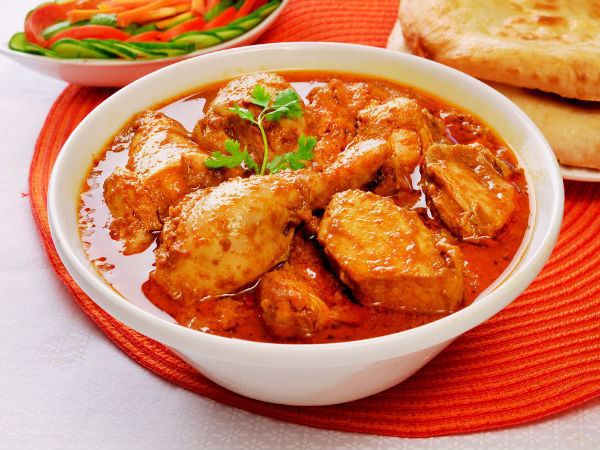 | ||
Similar Curry, Tikka, Biryani, Vindaloo, Masala | ||
Mutton korma daig style delhi special muglai dish by huma in the kitchen
Korma (from Turkish kavurma), also spelled kormaa, qorma, khorma, kurma, or qovurma, is a dish originating in South Asia consisting of meat or vegetables braised with yogurt or cream, water or stock, and spices to produce a thick sauce or glaze.
Contents
- Mutton korma daig style delhi special muglai dish by huma in the kitchen
- Chicken qorma or korma restaurant style chicken curry
- History
- In the United Kingdom
- Navratan korma
- In Azerbaijan
- In Bulgaria
- Preparation
- References
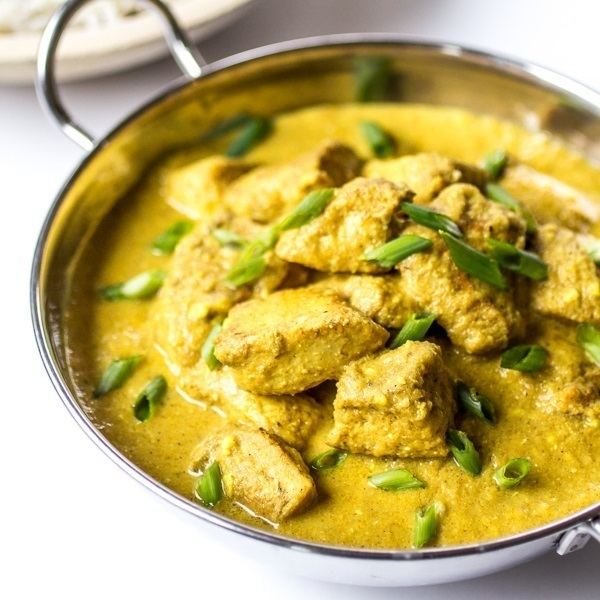
Chicken qorma or korma restaurant style chicken curry
History
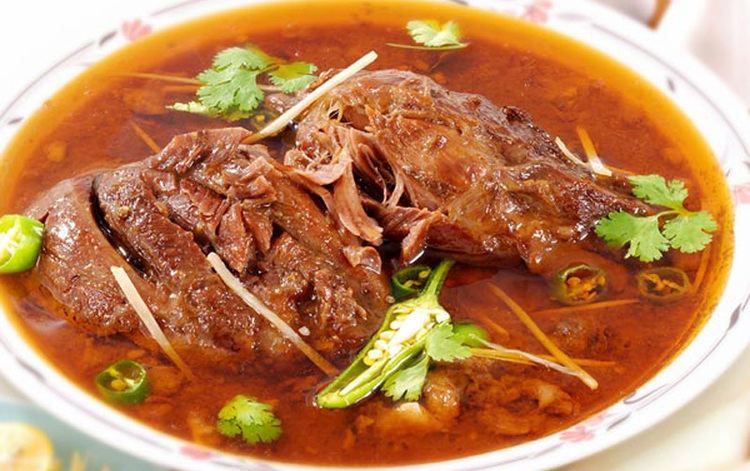
The word "korma" is derived from Urdu ḳormā or ḳormah, meaning "braise", derived in turn from Turkish kavurma, literally meaning "cooked meat". Korma (قورمه in Persian) has its roots in the Mughlai cuisine of modern-day India and Pakistan. It is a characteristic Moghul dish which can be traced back to the 16th century and to the Mughal incursions into present-day Northern India, Pakistan and Bangladesh. Classically, a korma is defined as a dish where meat or vegetables are braised with water, stock, and yogurt or cream added. The technique covers many different styles of korma.
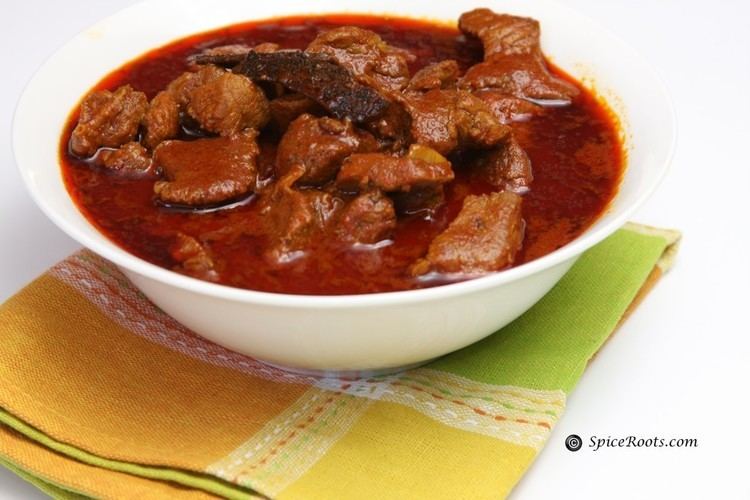
The flavour of a korma is based on a mixture of spices, including ground coriander and cumin, combined with yogurt kept below curdling temperature and incorporated slowly and carefully with the meat juices. Traditionally, this would have been carried out in a pot set over a very low fire, with charcoal on the lid to provide all-round heat. A korma can be mildly spiced or fiery and may use lamb, chicken, beef or game; some kormas combine meat and vegetables such as spinach and turnip. The term Shahi (English: Royal), used for some kormas indicates its status as a prestige dish, rather than an everyday meal, and its association with the court.
In the United Kingdom
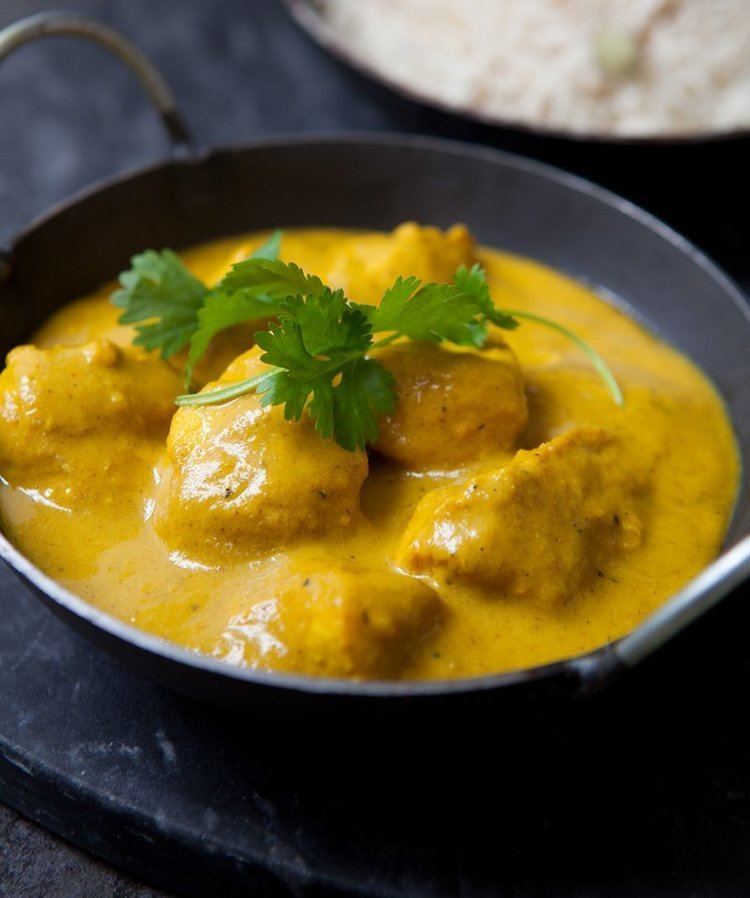
In the United Kingdom, a korma is a mildly spiced dish with a thick sauce, served in curry houses. It often features almonds, cashews or other nuts, and coconut or coconut milk.
Navratan korma

Navratan korma is a vegetarian korma made with vegetables and either paneer (an Indian cheese) or nuts – or sometimes both. "Navratan" means nine gems, and it is common for the recipe to include nine different vegetables.
In Azerbaijan
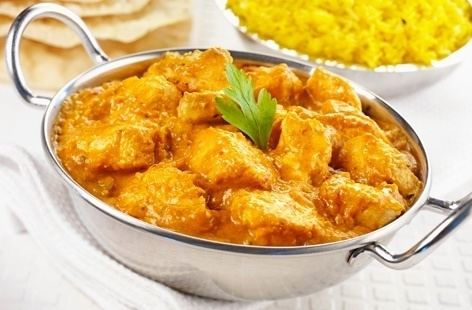
In Azerbaijan korma which is spelled as qovurma has several types such as lamb qovurma, liver qovurma and sabzi qovurma. Sabzi qovurma or lamb stew with herbs is a blend of Persian and Turkic cooking, as "sabzi" means "green" in Persian while "qovurma" means "fried meat" in Azerbaijani and other Turkic languages. Sabzi qovurma can be served with pilaf rice or as a dish on its own with yoghurt and crushed garlic.
In Bulgaria
Kavarma, also called kavarma kebap is a Bulgarian slow-cooked stew, typically made with pork and vegetables such as leeks. It is traditionally made in a lidded clay pot called a gyuveche. It is a popular dish in Bulgaria and there are many regional variations on the dish, some of which are spicy.
Preparation
The korma style is similar to all other braising techniques in that the meat or vegetable is first cooked briskly or seared using a high heat and then subjected to long, slow cooking using moist heat and a minimum of added liquid. The pot may be sealed with dough during the last stages of cooking.
Chicken or other poultry requires fairly thorough coating with the spice mixture, or marinating, and heating evenly in cooking oil or ghee at a high enough temperature to cook through, followed by a cooling period after which yogurt or cream may be added. However, lamb requires a very brief initial searing to brown the surface of each piece, followed by a braising at a continuous low temperature. This prevents the lamb from toughening, a particular problem if a large amount is to be cooked; temperature heterogeneity is difficult if the mixture is left to stand. This low cooking temperature is usually quite difficult to achieve, but if done correctly results in a memorable dish.
The korma can make use of a technique called bagar: later in the cooking, additional spices are mixed with heated ghee and then combined with the sauce formed by the braising; the pan is then covered and shaken to release steam and mix the contents.
There is a wide variation between individual korma and other "curry" recipes. Chilli and ginger are often used, but the precise method of preparation results in widely different flavors. Bay leaves or dried coconut may be added, the latter being a predominantly South Indian flavoring.
In few korma recipes coconut is used as the spice base like vegetable korma with coconut.
A korma pilau (pilaf) is a rice and meat dish made with braised meat.
